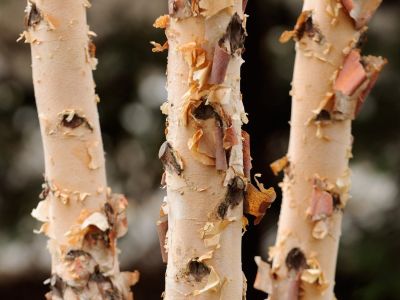If you think of birch trees as having papery white bark and green leaves, you aren’t wrong. Many varieties of birch trees share these features. But did you know that there are dozens of varieties of birch, even without counting birch tree cultivars, and that some have a very different appearance?
What Are the Different Types of Birch Trees?
If you are wondering about the different varieties of birch trees, read on. Here’s a round-up of our favorite varieties of birch. We have included some weeping birch varieties and some small birch varieties for more compact gardens.
- European birch (Betula pendula) This is a classic and extremely popular birch, one of the weeping birch varieties. It grows to between 30 and 60 feet (10 and 20 m.) tall and wide. The trunk has lovely white bark with black fissures, and the branches are drooping. The leaves of this birch are green in summer, canary yellow in fall. It prefers a full sun location and well-draining moist soil.
- Paper birch (Betula papyrifera) With white peeling papery bark and green leaves, the paper birch looks a lot like the European birch except that its branching structure is upright. It’s a rock-star tree, growing fast and dying young, but very helpful for wildlife, attracting many wild birds and hosting the larvae of Luna moths. Plant in sun and keep the soil moist.
- River birch (Betula nigra) River birch trees have attractive trunks in shades of red from cinnamon to salmon. The bark peels and curls. The foliage is glossy green during summer, then blazes yellow in autumn. This is a birch that tolerates heat, part shade, and some drought, unlike many of its family members.
- Black birch (Betula lenta) How about a birch with dark brown bark? The black birch’s bark resembles the bark of a cherry tree but happens to be extremely fragrant with a wintergreen scent. The tree’s green leaves turn golden in fall. It is not one of the small birch varieties and can grow to 90 feet (30 m.) tall.
- Gray birch (Betula populifolia) resembles the paper birch. However, this species normally grows with multiple trunks and its bark is whitish-gray and doesn’t peel. It will grow in dry and sandy soils, though it, like most birch, prefers moist soil.
- Yellow or golden birch (Betula alleghaniensis) If you like birch with peeling bark, consider the yellow birch. Its handsome copper-colored bark peels off in sheets, and it also offers a yellow autumn display. No dry or sandy soils for this native, and no hot sites either. Yellow birch is a tall deciduous tree, its single trunk rising to 80 feet (27 m.) tall, making it one of the largest birches in North America.
- Japanese White Birch (Betula platyphylla ‘Japonica’) Native to Korea and Japan, this species is one of the weeping birch varieties. It is a medium tall tree, growing to 50 feet (17 m.) tall, in USDA zones 3 to 8. It has white bark and thin spreading branches with drooping branchlets. It can thrive in moist, well-drained loam in full sun.
- Water birch (Betula occidentalis or Betula fontinalis) This attractive birch is among the small birch varieties, as it only grows to 25 feet (8 m.) as a shrub and 40 feet (12.5 m.) as a tree. In the wild, water birch trees grow next to streams in mountainous regions in zones 3 through 7. The attractive bark is dark mahogany and smooth, not peeling. Beavers use this tree for food and lodge material.
- Dwarf Birch (Betula nana) Another of the small birch varieties, dwarf birch is a native of cool tundra landscapes in USDA zones 1 through 8, including Alaska, Canada, Greenland, and northern Asia. It truly is a dwarf species, topping out at 3 feet (.9 m.) tall. Like most birch, it prefers wet but well-drained soil and full sun.
- Himalayan Birch (Betula utilis var. jacquemontii) It’s a winning combination for Himalayan birch: lovely spring flowers, deep gold fall foliage, and bright white papery bark. This medium-sized tree –to 50 feet (17 m.) – grows into a pyramid shape from its single trunk. It thrives best in cooler climates like USDA zones 4 through 7 where the birch is a heartier and longer-lived tree.
